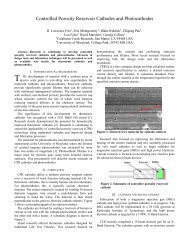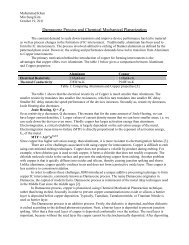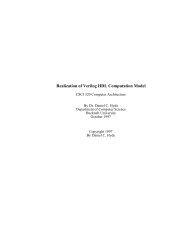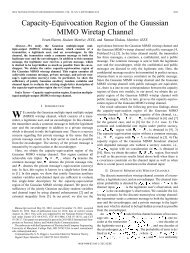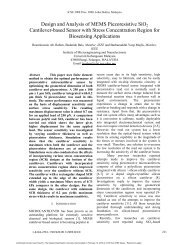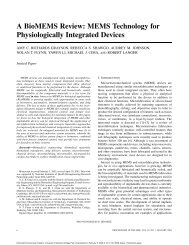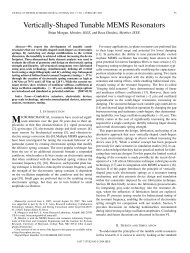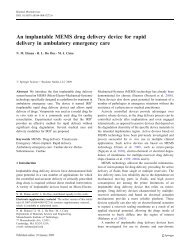Fall 2011 - ECE - University of Maryland
Fall 2011 - ECE - University of Maryland
Fall 2011 - ECE - University of Maryland
You also want an ePaper? Increase the reach of your titles
YUMPU automatically turns print PDFs into web optimized ePapers that Google loves.
economics” said Pr<strong>of</strong>essor JaJa.<br />
Located in Annapolis, Md., the center<br />
is supported primarily by the National<br />
Science Foundation through a $27.5<br />
million, five-year grant. Additionally,<br />
SESYNC has received substantial support<br />
from the state <strong>of</strong> <strong>Maryland</strong>. State <strong>of</strong>ficials<br />
expect the center to take on critical local<br />
issues like the health <strong>of</strong> the Chesapeake Bay,<br />
while also addressing issues that affect the<br />
mid-Atlantic region and beyond, including<br />
sustainable energy and human behavior as it<br />
relates to climate adaption.<br />
<strong>Maryland</strong> Governor Martin O’Malley<br />
said it is fitting for the center to have the<br />
Chesapeake Bay on its doorstep because<br />
the bay and SESYNC each perfectly reflect<br />
the multifaceted challenge <strong>of</strong> today’s major<br />
environmental issues and the essential<br />
response needed. “The center’s approach to<br />
environmental challenges through collaborative<br />
science-based responses drawn from many<br />
disciplines while factoring in human and<br />
ecosystem needs is exactly the approach that<br />
the bay needs in our efforts to restore it.”<br />
Senior staff at SESYNC will strive to<br />
concentrate the expertise <strong>of</strong> environmental,<br />
social, and computational scientists,<br />
engineers, economists, and public policy<br />
experts world-wide by inviting them to visit<br />
and participate in the exploration <strong>of</strong> two or<br />
more major themes annually. The executive<br />
team foresees participation in ten to fifteen<br />
ongoing projects at a time.<br />
Dr. JaJa will work with a staff <strong>of</strong><br />
post-doctoral fellows and programmers to<br />
lead computational projects and allocate<br />
resources; engaging participants through<br />
data and model sharing and interacting with<br />
environments based on social networks.<br />
The major challenge he and his staff will<br />
encounter is to combine and aggregate<br />
data, models, and information to foster the<br />
synthesis process.<br />
Another equally important goal<br />
<strong>of</strong> SESYNC will be to improve and<br />
popularize the research and problemsolving<br />
underpinnings <strong>of</strong> the synthesis<br />
process. As this is accomplished across<br />
disciplines through the center’s projects,<br />
SESYNC plans to develop a foundation<br />
to promote the synthesis process, which<br />
could be integrated into educational<br />
curricula worldwide.<br />
Education research and activities<br />
will be embedded throughout SESYNC’s<br />
programs to expand the ability <strong>of</strong> researchers<br />
and students to effectively synthesize<br />
environmental science with social science<br />
research and knowledge. Programs will focus<br />
on teaching synthesis methods and strategies<br />
for the analysis <strong>of</strong> complex information<br />
on the environment to diverse educational<br />
communities, with an emphasis on<br />
undergraduate education.<br />
While addressing urgent questions<br />
on ecosystem management SESYNC will<br />
educate the public—homeowners, watermen,<br />
farmers and legislators—on being part <strong>of</strong> the<br />
solution. These efforts will be reflected in the<br />
relationship with the greater community<strong>of</strong>fering<br />
tours, visits, workshops, blogs and<br />
online forums.<br />
“Engineering and scientific solutions<br />
need to be proved feasible through social<br />
science, policy makers, and the practical<br />
applications initiated by everyday people. I am<br />
excited to be at the forefront <strong>of</strong> this ambitious,<br />
and transformative endeavor,” concludes JaJa.<br />
“The collaborations <strong>of</strong> this<br />
new <strong>University</strong> <strong>of</strong> <strong>Maryland</strong> center<br />
represent exactly the kind <strong>of</strong> innovative,<br />
interdisciplinary approaches that are<br />
essential if we are to tackle the complex<br />
environmental challenges facing our<br />
nation and world,” said Wallace D. Loh,<br />
president <strong>of</strong> the <strong>University</strong> <strong>of</strong> <strong>Maryland</strong>,<br />
College Park. C<br />
A. JAMES CLARK SCHOOL <strong>of</strong> ENGINEERING � GLENN L. MARTIN INSTITUTE OF TECHNOLOGY<br />
<strong>ECE</strong> Innovations in<br />
Spotlight at Invention<br />
<strong>of</strong> the Year Awards<br />
Researchers from the Department <strong>of</strong> Electrical<br />
and Computer Engineering (<strong>ECE</strong>) were<br />
honored at the <strong>University</strong> <strong>of</strong> <strong>Maryland</strong>’s<br />
24th annual Invention <strong>of</strong> the Year Awards,<br />
organized by the university’s Office <strong>of</strong><br />
Technology Commercialization.<br />
A team consisting <strong>of</strong> Christine Yurie<br />
Kim Eminent Pr<strong>of</strong>essor <strong>of</strong> Information<br />
Technology K. J. Ray Liu, Wan-Yi Lin, and<br />
Nathan Goergen won Invention <strong>of</strong> the Year<br />
in the Information Science category for their<br />
invention, titled, “Active Sensing for Dynamic<br />
Spectrum Access.”<br />
The inventors presented a new<br />
framework that takes an active approach<br />
to spectral sensing for dynamic spectrum<br />
access (DSA) applications. In wireless shared<br />
spectrum scenarios, licensed digital television<br />
stations take a primary user role and are given<br />
explicit first-right-<strong>of</strong>-access to the television<br />
spectrum. When a primary user signal is not<br />
present, broadband users are allowed to use<br />
shared spectrum. The “active sensing” scheme<br />
encourages primary users to actively help<br />
spectrum sensing by embedding their own<br />
unique, ID into the transmitted signal.<br />
Another team, consisting <strong>of</strong> <strong>ECE</strong><br />
Pr<strong>of</strong>essor Christopher Davis, Civil<br />
Engineering Research Pr<strong>of</strong>essor Stuart<br />
Milner, and <strong>ECE</strong> alumnus Jamie Llorca,<br />
was a runner-up in the Information Sciences<br />
category for their invention, titled, “Self-<br />
Optimization, Dynamic Positioning and<br />
Mobility Management in Wireless Networks.”<br />
The inventors developed novel models and<br />
methods for controlling and positioning<br />
directional wireless backbone (DWB)<br />
platforms in order to guarantee their coverage<br />
<strong>of</strong> mobile and user devices, while ensuring<br />
that the backhaul bandwidth and quality <strong>of</strong><br />
service are maximized. C<br />
5



